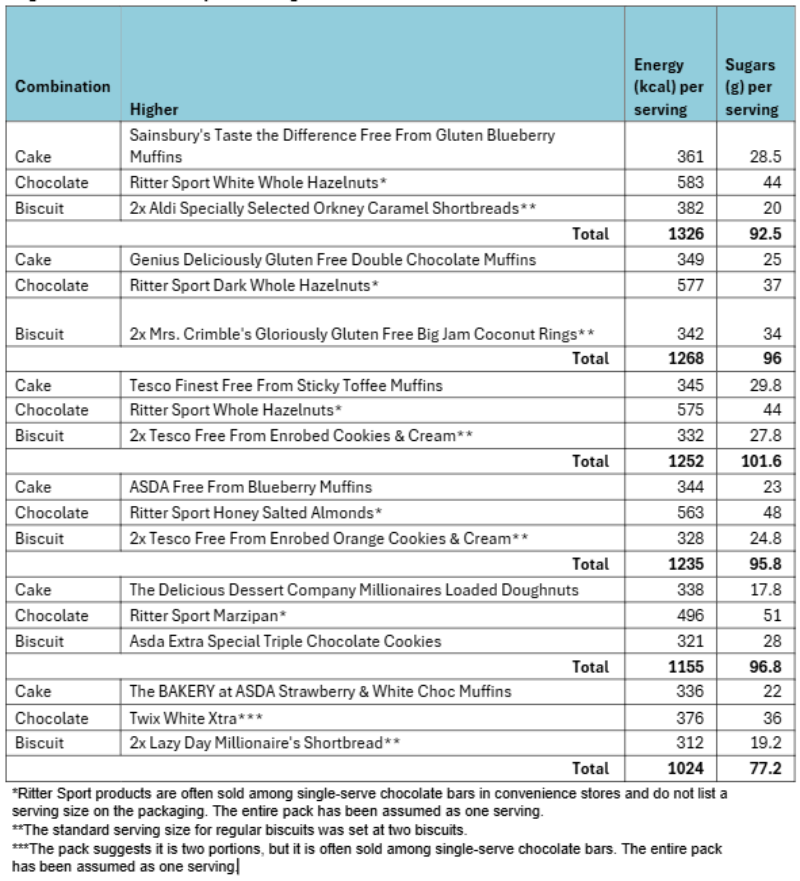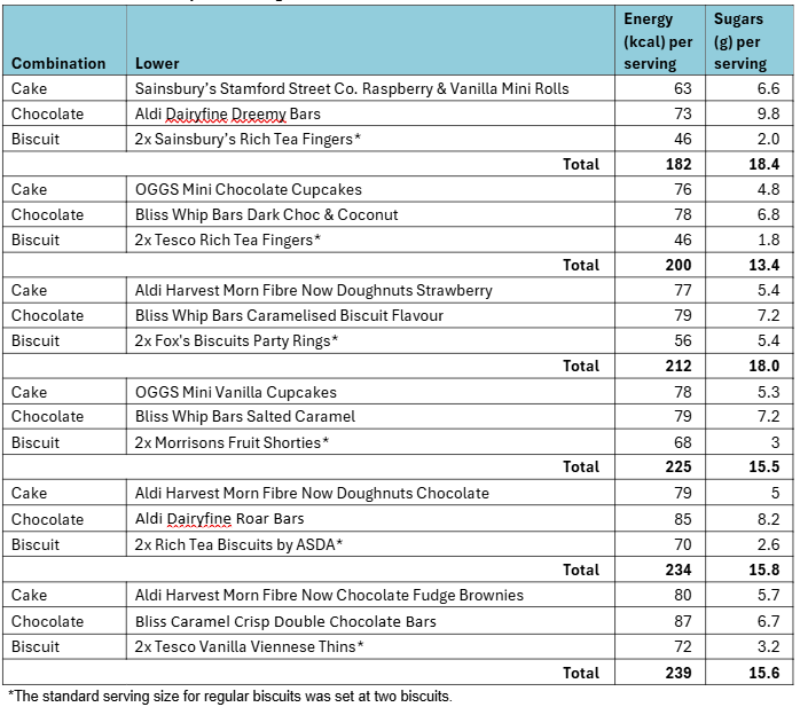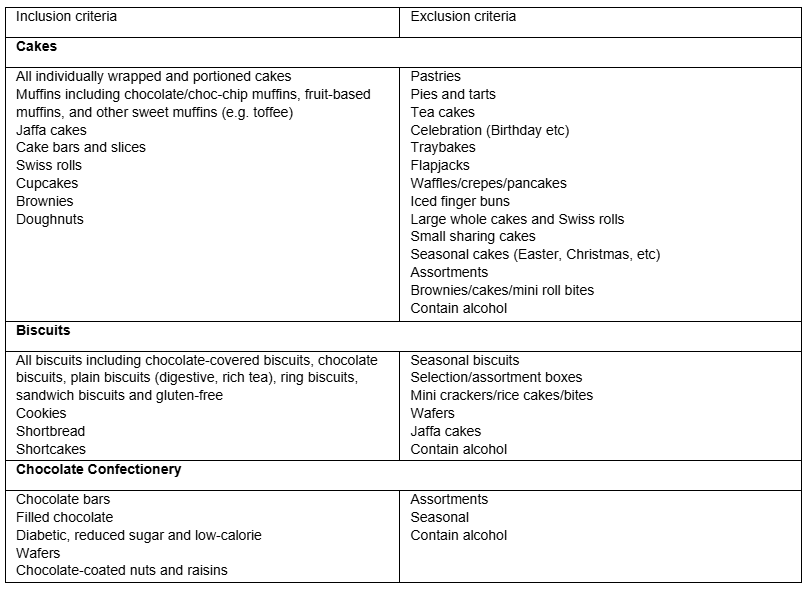Top Researchers Demand Government Action to Stop the Sugar Flood in Children’s Diets
- Cakes, chocolate, and biscuits continue to drive excessively high sugar intake amongst children, despite the Government’s voluntary Sugar Reduction Programme for businesses.
- Just a single cake at lunch in school [1], a chocolate bar on the way home, and one or two biscuits after dinner can add up to 1,326 kcals and 92.5 grams of sugar in a single day – that’s nearly 23 teaspoons of sugar!
- Call to expand the Soft Drinks Industry Levy to cover foods that are driving excess sugar intake in children and ban cakes and biscuits in schools.
To mark Sugar Awareness Week, Action on Sugar at Queen Mary University of London [2], has unveiled alarming new data on the high levels of sugar and calories in popular sweet snacks [3].
A recent survey of individually packaged or portioned sweet snacks reveals that a typical combination – such as a cake [4], a chocolate bar, and one or two biscuits consumed over the course of a day – can pack an astounding 1326 calories and 92.5 grams of sugar. This amount is three times the recommended daily sugar limit for children aged 11+ [5].
In fact, the data also shows that 61% of cakes, 63% of chocolate confectionery and 44% of biscuits surveyed equal or exceed one-third (10g) of the daily sugar limit for children aged 11+ per serving.
As cakes, chocolate confectionery, and biscuits remain major contributors to high sugar intake among children – and with limited success from the government’s voluntary Sugar Reduction Programme – Action on Sugar is urging the government to extend the successful mandatory Soft Drinks Industry Levy to include these and other high-sugar foods. Revenue from this expanded levy could then fund initiatives aimed at improving children’s health.
Furthermore, the current School Food Standards may be driving children to exceed their daily sugar limits by allowing cakes and biscuits at lunchtime [1]. Action on Sugar is also calling for a ban on such sugary foods that result in children exceeding their maximum daily limit of sugar at school, alongside the creation of healthier local food environments around schools to help young people eat better.
In the survey of cakes (185), chocolate confectionery (92), and biscuits (360), the worst combination ranked by calories per serving was one of the Sainsbury's Taste the Difference Free From Gluten Blueberry Muffins, which contains 361 kcals and 28.5g of sugar (∼7 teaspoons), combined with the Ritter Sport White Whole Hazelnuts containing 583 kcals and 44g of sugar (∼11 teaspoons) and two Aldi Specially Selected Orkney Caramel Shortbreads containing 382 kcals and 20g of sugar (∼5 teaspoons) [6]. Other similar combinations (Table 1) show the ease in which children can overconsume calories and sugar from these categories.
Although lower-calorie and lower-sugar options are available (Table 2), there are concerns about how effectively our current food environment promotes these lower-sugar options.
Whilst these findings highlight the urgent need for decisive government action to reduce excessive sugar consumption amongst young people, the data also emphasises the failure of the Government’s voluntary Sugar Reduction Programme which aimed to reduce sugar by 20% in key product categories by 2020. The programme fell far short of its target, achieving minimal reductions in categories like cakes (-3.2%), biscuits (-3.1%), and chocolate confectionery (-0.9%) – a stark contrast to the 20% reduction needed to make a meaningful impact on children’s health [7]. In comparison, the Government’s mandatory Soft Drinks Industry Levy achieved a significant 34.3% reduction in sugar content.
Furthermore, the Government’s 2020 sugar reduction progress report showed that, despite minimal average reductions in sugar content within chocolate confectionery, the sales of sugar from these products increased by a staggering 26.9% between 2015 and 2020 [7].
Despite commitments in the government’s 2016-2018 childhood obesity plan to update the School Food Standards in line with the revised sugar guidelines [8], this update has yet to be implemented. In fact, recent research shows secondary schools in England are not fully complying with the School Food Standards, likely due to lack of external monitoring [9] and funding [10]. The Department for Education must now revise the School Food Standards and ensure schools including academies are complying by providing support. This was highlighted in the recent House of Lords report too, where they called for the immediate revision of the standards [11].
Dr Kawther Hashem, Head of Research and Impact at Action on Sugar based at Queen Mary University of London says: “The truth is, sugary foods are almost inescapable for most children – they’re readily available in schools and often the easiest choice on the way home. We’re simply not doing enough to support children in keeping their sugar intake within recommended guidelines. We have a duty to every child to make school a sanctuary from unnecessary sugar, so they can grow up healthier, stronger, and free from the risks of diet-related disease.”
Nourhan Barakat, Nutritionist at Action on Sugar based at Queen Mary University of London explains: "Shocking but true – children can consume 92.5 grams of sugar and over 1,300 calories from just 3 common snacks! A cake for dessert at school, a chocolate bar on the way home, and a few biscuits after dinner can push their sugar intake to triple the daily limit. If sugar in these snacks were reduced by 20%, they would still be sweet, but with nearly 20 grams less sugar being consumed, it’s time food companies prioritise children’s health and cut sugar in everyday snacks."
Professor Graham MacGregor, Chair of Action on Sugar based at Queen Mary University of London adds: “Whilst the previous Government’s Sugar Reduction Programme failed due to a lack of meaningful enforcement, the Soft Drinks Industry Levy proved that targeted, well-orchestrated action works. This new government now has a unique opportunity to prioritise the health of the nation by implementing a clear, straightforward approach across the food and drink industry which could save the NHS billions and save many thousands of lives.”
Table 1: Examples of cake, chocolate confectionery and biscuit combinations with higher calorie content per serving
Table 2: Examples of cake, chocolate confectionery and biscuit combinations with lower calorie content per serving
Ends
For more information contact: David Clarke @ Rock PR:
E: david@rock-pr.com M: 07773 225516
Join the conversation on X @actiononsugar and LinkedIn
Notes to editors:
Action on Sugar is a group of specialists concerned with sugar and its effects on health. It is successfully working to reach a consensus with the food industry and Government over the harmful effects of a high sugar diet and bring about a reduction in the amount of sugar in food and drink products.
Data has been collected from various sources, including information directly from company websites and from The George Institute’s Global Database of food and drink (via FoodSwitch). Our licensing contract with the George Institute states that we are legally not permitted to share data obtained from their FoodSwitch database.
Reference
1. According to the current School Food Standards, desserts, cakes and biscuits are allowed during lunchtime. They must not contain any confectionery. They include manufactured, bought-in products and prepared from scratch cakes and biscuits such as individual cakes, buns and pastries, scones and sweet biscuits during lunchtime. https://www.schoolfoodplan.com/wp-content/uploads/2015/01/School-Food-Standards-Guidance-FINAL-V3.pdf
2. The research is conducted by Action on Sugar based at the Research and Action on Salt and Obesity Unit, within the Centre for Public Health and Policy at the Wolfson Institute for Population Health in partnership with Recipe for Change. Recipe for Change is a coalition of 46 well-known health organisations (including Sustain, Food Foundation, Obesity Health Alliance, British Heart Foundation, Action on Salt and Sugar and Impact on Urban Health), Royal Colleges and charities are calling on the Government to build on the success of the Soft Drinks Industry Levy and further regulation to make food healthier and raise additional revenues for investment in children’s health.
3. About the product survey
- The survey looked at individually wrapped or individually portioned cakes, chocolate confectionery and biscuits.
Data collection: Products were selected according to inclusion and exclusion criteria in table below), inspired by the UK Sugar Reduction Programme. Full nutrition information per 100g and serve for cakes and biscuits was collected online between 15th April and 3rd June 2024 from the five retailers with the largest market share in the UK (Asda, Aldi, Morrisons, Sainsbury’s and Tesco) according to Kantar in 2024 https://www.kantarworldpanel.com/grocery-market-share/great-britain. The Full nutrition information per 100g and serve for chocolate confectionery were collected in store using the FoodSwitch Data Collector App in nine retailers in Sept-Nov 2023 and any missing products were collected online in June 2024.
- Inclusion and Exclusion Criteria
- Data per serving:
Biscuits: Individually wrapped biscuits packaged as one serving, singular or in multi-packs were considered one serving.
We calculated the per serving size of:
- large in store bakery cookies to be one serving.
- regular biscuits from large packs of smaller portioned biscuits as two biscuits, aligning with some retailer and branded pack’s suggested serving size.
- chocolate fingers as five fingers, aligning with Asda's suggested serving size.
Products without a serving weight on the packaging were excluded, as we could not adjust the serving size to two biscuits.
Chocolate confectionery: Individually wrapped chocolate confectionery, singular or in multi-packs were considered one serving. Products up to 100g with no per serving information and sold among other single serve chocolate confectionery bars in three or more convenience stores was also considered one serving. We calculated the serving size for chocolate buttons as the entire pack of 25g or 30g.
Cakes: Individually portioned and individually wrapped cakes, muffins, loaves, cupcakes, mini rolls, doughnuts and brownies were considered one serving. We calculated the per serving size of Jaffa cakes as three cakes, aligning with the McVitie’s Jaffa Cakes The Original snack pack.
- Data verification: The nutrition information of the 10 highest and lowest calories per serving of cakes, chocolate confectionery and biscuits were checked online and in store in October and November 2024. Products unavailable for purchase online and in store, even after several visits, were assumed to be discontinued, and excluded from the survey. Figures in this release are based on the nutrition information provided. Retailer own branded products have been shared with companies for verification ahead of its release (only Aldi have confirmed their data). All products mentioned in this PR have been verified from product packaging (purchased in October and November) or online.
4. The cake category in the government’s Sugar Reduction Programme also includes brownies, mini rolls and doughnuts, therefore for the purpose of this survey, they were also included under the ‘cake’ category.
5. An 11+ year old’s maximum recommended intake of free sugars is no more than 30g, roughly equivalent to 7 teaspoons. https://www.nhs.uk/live-well/eat-well/food-types/how-does-sugar-in-our-diet-affect-our-health/#:~:text=This%20means%3A,day%20(5%20sugar%20cubes)
6. 4g sugar is equivalent to 1 teaspoon.
7. Office for Health Improvement and Disparities. 2022. Sugar reduction – industry progress 2015 to 2020. https://assets.publishing.service.gov.uk/media/6388cd71d3bf7f328c0ded27/Sugar-reduction-and-reformulation-progress-report-2015-to-2020.pdf
8. HM Government. 2016. Childhood Obesity A Plan for Action. https://assets.publishing.service.gov.uk/government/uploads/system/uploads/attachment_data/file/546588/Childhood_obesity_2016__2__acc.pdf
9. Pallan, M., Murphy, M., Morrison, B. et al. 2024. National school food standards in England: a cross-sectional study to explore compliance in secondary schools and impact on pupil nutritional intake. Int J Behav Nutr Phys Act 21, 123. https://doi.org/10.1186/s12966-024-01672-w
10. Tes Magazine. 2024. Food standards: why are schools not complying? The problems with the School Food Standards | Tes
11. House of Lords. 2024. Recipe for Health: a plan to fix our broken food system. https://publications.parliament.uk/pa/ld5901/ldselect/ldmfdo/19/19.pdf





